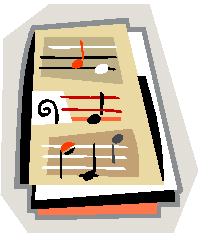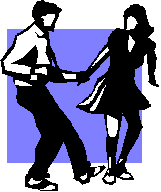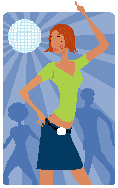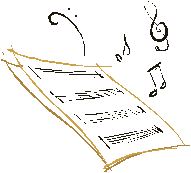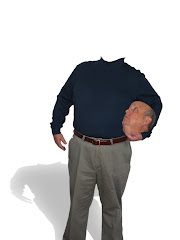Tuesday, July 29, 2008
What are "piano tabs"?
Piano tabs, strictly speaking, are a form of sheet music that notates the music by showing where the fingers are to be placed instead of the notes themselves; the form is also known as tablature and is frequently used for guitar, as well. Technically, there is no such thing as piano tab. Tablature, though vast in its capabilities, is only intended for fretted string instruments, and while piano is certainly a string instrument, it isn't fretted. The term piano tab is actually used to refer to fingering charts (charts often used in instruction to aid in the correct placement of the fingers on the keys) or, most commonly, traditional sheet music.
Piano tab in terms of traditional sheet music is the written notation for a piece of music. It tells that musician what to play, for how long and in what sort of manner. Notes are dictated via a series of ovals, often stemmed, on a musical staff consisting of five lines and four spaces. Where the notes are located vertically on the staff indicates what pitch is to be played, and the note's physical appearance in the piano tab indicates its duration. Piano tab also includes other specifications like time signature (the song's meter), key signature (the key in which the song is played) and tempo (the speed at which the song is played).
Not all piano tab indicates the same things, however. Some piano tab, especially that found in jazz ensembles and popular music groups, is very limited, notating only the bare essentials of chord progression and tempo. In this case, piano tab is really just a quick reminder of what needs to be played; it certainly isn't relied on for the detailed nuance of the song. And some piano tab, often referred to as a score, is extremely detailed, including not only the piano parts, but the parts of every other instrument as well. This type of piano tab is intended mostly for conductors, though sometimes pianists use condensed versions as a guide to the overall melody.
___________________________
Thursday, July 24, 2008
What is a "foxtrot"?
_
The foxtrot is a ballroom dance named after Harry Fox, the vaudeville actor who invented it in the early 1900s. It's an altered version of the popular two-step but with two quicker steps (otherwise known as trots) figured in, making the dance pattern slow-slow-quick-quick. The wildly popular foxtrot eventually branched into two separate evolutions: the quickstep, which is a combination of the foxtrot and the charleston danced to much faster music, and the slowfox, the slower version of the foxtrot that retains most of its original qualities. Both are still danced today, though the quickstep seems to be the most common.
Though all music used to dance the foxtrot became known as foxtrot music, it was initially danced exclusively to ragtime. Foxtrot ragtime is a syncopated style of music characterized by a bass note on the first and third beats and short chords on the second and fourth; foxtrot ragtime (or ragtime in general) is also known for its use of the walking bass. It's a fairly upbeat, energetic style of music that fit surprisingly well with the happy foxtrot.
Ragtime music, in all of its many forms, eventually became so entwined with the foxtrot that all ragtime was considered by some to be merely foxtrot music. But it's important to note here that foxtrot ragtime, in all its popular glory, was a late, late version of the influential style of music. Prior to the foxtrot craze, ragtime was slightly less syncopated and of a slightly different dynamic. It was certainly a danceable style of music, but it didn't become exclusively associated with any one dance until the foxtrot was popularized in the early 1900s. Foxtrot ragtime, the late version that accompanied the dance, added a syncopated dotted-note beat to accommodate the foxtrot steps. The foxtrot, even as it lost some of its steam, eventually moved on to be danced to a variety of musical styles, but its earliest heyday will always be associated with the late era of foxtrot ragtime.
____________________________
The foxtrot is a ballroom dance named after Harry Fox, the vaudeville actor who invented it in the early 1900s. It's an altered version of the popular two-step but with two quicker steps (otherwise known as trots) figured in, making the dance pattern slow-slow-quick-quick. The wildly popular foxtrot eventually branched into two separate evolutions: the quickstep, which is a combination of the foxtrot and the charleston danced to much faster music, and the slowfox, the slower version of the foxtrot that retains most of its original qualities. Both are still danced today, though the quickstep seems to be the most common.
Though all music used to dance the foxtrot became known as foxtrot music, it was initially danced exclusively to ragtime. Foxtrot ragtime is a syncopated style of music characterized by a bass note on the first and third beats and short chords on the second and fourth; foxtrot ragtime (or ragtime in general) is also known for its use of the walking bass. It's a fairly upbeat, energetic style of music that fit surprisingly well with the happy foxtrot.
Ragtime music, in all of its many forms, eventually became so entwined with the foxtrot that all ragtime was considered by some to be merely foxtrot music. But it's important to note here that foxtrot ragtime, in all its popular glory, was a late, late version of the influential style of music. Prior to the foxtrot craze, ragtime was slightly less syncopated and of a slightly different dynamic. It was certainly a danceable style of music, but it didn't become exclusively associated with any one dance until the foxtrot was popularized in the early 1900s. Foxtrot ragtime, the late version that accompanied the dance, added a syncopated dotted-note beat to accommodate the foxtrot steps. The foxtrot, even as it lost some of its steam, eventually moved on to be danced to a variety of musical styles, but its earliest heyday will always be associated with the late era of foxtrot ragtime.
____________________________
Wednesday, July 23, 2008
What is "Disco"?
Disco is a funk-influenced style of music completely particular to the 1970s. It represents, quite possibly, one of the largest and most short-lived crazes of modern times; as quickly as it came rushing in, it came crashing down. Disco music itself, apart from the trend, is characterized by a solid bass driving the song (and often offering the only melody), guitar mired in wah-wah pedal, and very specific drumbeat: a steady kick drum hit on every 4/4 beat, snare on the second and fourth beats and an eight-beat hi-hat shuffle that opens at every snare. Sounds complicated, but this disco beat is shockingly familiar outside of the text.
Disco music at first was never intended for listening; it was simply the soundtrack to a dance phenomenon. The music, as well as the trend, reflected a sort of decadence that served as the anti-hippie; instead of fighting civil hatred with hugs and love, the disco era fought it with drugs and dancing, hedonism. But even as disco spawned out of fairly noble, political roots, its commercialization stripped it of any sort of social commentary. Disco remained largely underground until the movie "Saturday Night Fever" shed light on the trend. Suddenly, the music became listenable outside of the dance, and the dance was all anyone wanted to do. Record labels began releasing disco albums at warp speed, and even rock bands like Kiss hopped on the wagon by creating disco-driven singles.
This level of saturation was all the trend needed to come to a grinding halt. People began to loathe it as quickly as others had loved it, and the backlash against disco was one of the largest in music history. Disco albums were burned and clubs were abandoned; the commercialization that brought so many people so much money was suddenly seen as the downfall of modern musical society. Rock bands, specifically the influx of anti-disco punks, were the new saviors.
Ironically and strangely, disco has recently seen a revival within the very scene that once shunned it. New independent bands with an ear for the past have recently begun toying with the disco beat, creating something coined by critics as "disco punk." But, just like they did before, modern rock fans have grown tired of the disco revival, spawning a new backlash that shows no immediate signs of stopping. Disco is one area of music that makes a revival next to impossible.
__________________________
Monday, July 21, 2008
Piano Chord Symbols: Slash Chords
Slash chords are chords that look like this:
C/Bb or F/A or G7/F etc.
C/Bb or F/A or G7/F etc.
Improvising Piano Blues
Improvising the blues on the piano involves learning the structure of the blues as well as the blues scale.
How To Create A "Flowing River of Sound" on the Piano
Use open-voiced arpeggios in the left hand while playing broken chords in the right hand.
Half-Step Slides: Piano Chord Substitutions
One of the best ways to make an interesting chord substitution is to use 1/2 step slides. Substitute the chord that is 1/2 step above the target chord before you arrive at that chord.
How To Make a Piano Sound Like Bells & Chimes
You can make your piano sound like bells and chimes by learning two simple techniques -- one for bells and one for chimes.
What is a piano "Score"?
A piano score is a type of ensemble sheet music intended solely for the piano. Like all sheet music, it is a song's written notation; a piano score tells the musician what to play and how to play it. Unlike all sheet music, however, a piano score shows not only the piano part but nearly every other part in the ensemble as well. It can be a confusing piece of sheet music; the pianist must get used to following their part closely in conjunction with the other ensemble instruments. Traditionally, this is the job of the conductor. A normal conductor's score will notate every part of the ensemble in one large book of sheet music to aid the conductor in focusing on the various instruments. A piano score, however, is handled completely by the pianist. While it may mirror the score used by the conductor, it is rarely an exact replica; the notations, after all, are intended for an actual musician in the ensemble as opposed to the person directing it.
A piano score is used in a variety of different forms and genres; it knows no boundaries of style. The type of piano score used is often based solely on the type of music or ensemble. The pianist in a large ensemble, such as an accompanying orchestra to a theatrical performance, will often use a partial piano score. This type of piano score doesn't include every single instrument, just the parts vital to the pianist's understanding of the melody and rhythm; partial piano scores (despite being only partial) are still fairly detailed. A full piano score is usually only used by smaller ensembles, though even the small ensembles revert to a partial piano score at times. Jazz musicians particularly use a partial piano score even less detailed than a large orchestra's piano score. Due to the improvisatory nature of jazz music, detailed sheet music is rarely necessary; depending on the ensemble, the sheet music functions more as flexible notes than anything else. A piano score in jazz works in this manner. It gives the pianist vital reminders about the melody, rhythm or harmony, but allows for variations on the overall theme; a piano score here will only show what truly needs to be shown.
___________________________
Sunday, July 20, 2008
What is a "Samba"?
Samba is a sort of carnival genre of music and dance. Rooted in Rio de Janeiro, it's the most popular and well-known genre to come out of the Afro-Brazilian culture, a culture created by the slave trade from Africa to Brazil. It's a very percussive, energetic form of music; as its roots are in carnival parades and celebrations, the samba's earliest forms has occasional similarities in dynamic to that of marching bands. But the similarities end there; samba is a full-fledged form intended for dancing, not marching. It's rhythmically unique and culturally vital to Rio de Janeiro and other parts of Brazil.
Like many music and dance genres, the samba is rooted in peasant culture. Groups of neighbors in poor Rio neighborhoods played the music together to sing and dance to and soon adapted the style to become part of their yearly carnival celebration. The samba quickly became an integral part of carnival; the celebratory music was played during carnival parades, and its inclusion made carnival samba a large production. Each samba school (a samba group named so because they often practiced in school yards) performing at carnival included singers, dancers, and an overwhelming drum section in addition to other instruments. The samba schools created large, colorful floats and the dancers' costumes were equally as intricate and bright. A samba school's preparations for carnival (which takes place early in the year) would often start as early as July with an incredible number of people working behind the scenes to create the aesthetic. Musicians, too, started this early, working to create an original composition to be used as the yearly parade piece.
Samba stayed largely within the Brazilian underground until 1917 when the first samba recordings appeared; "Pelo Telofone" is believed to be the first recording, though the composition has been attributed to a few different people. This recording and the others that followed brought samba out of the Rio underground and into the limelight; the irresistible energy found in samba quickly caught on in the United States where it became a music and dance phenomenon. The samba dance, a Brazilian tango-based 2/4 step taken directly from the carnival dancers, was altered as it shifted cultures, and soon became the ballroom samba that most Americans know today. The traditional samba is still danced in Brazilian carnival parades.
___________________________
Like many music and dance genres, the samba is rooted in peasant culture. Groups of neighbors in poor Rio neighborhoods played the music together to sing and dance to and soon adapted the style to become part of their yearly carnival celebration. The samba quickly became an integral part of carnival; the celebratory music was played during carnival parades, and its inclusion made carnival samba a large production. Each samba school (a samba group named so because they often practiced in school yards) performing at carnival included singers, dancers, and an overwhelming drum section in addition to other instruments. The samba schools created large, colorful floats and the dancers' costumes were equally as intricate and bright. A samba school's preparations for carnival (which takes place early in the year) would often start as early as July with an incredible number of people working behind the scenes to create the aesthetic. Musicians, too, started this early, working to create an original composition to be used as the yearly parade piece.
Samba stayed largely within the Brazilian underground until 1917 when the first samba recordings appeared; "Pelo Telofone" is believed to be the first recording, though the composition has been attributed to a few different people. This recording and the others that followed brought samba out of the Rio underground and into the limelight; the irresistible energy found in samba quickly caught on in the United States where it became a music and dance phenomenon. The samba dance, a Brazilian tango-based 2/4 step taken directly from the carnival dancers, was altered as it shifted cultures, and soon became the ballroom samba that most Americans know today. The traditional samba is still danced in Brazilian carnival parades.
___________________________
Subscribe to:
Posts (Atom)
